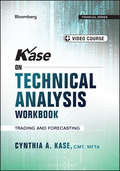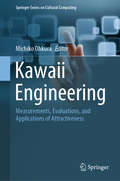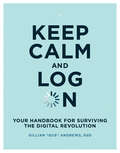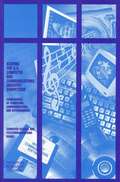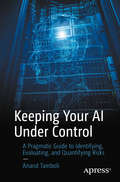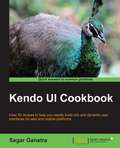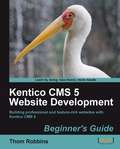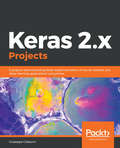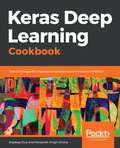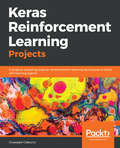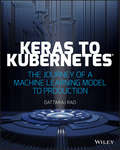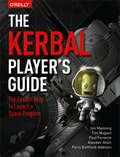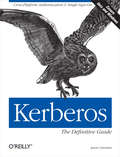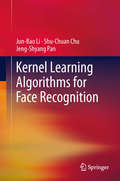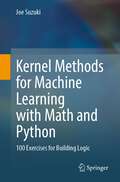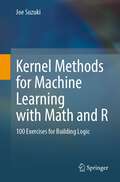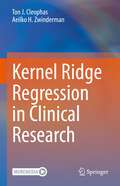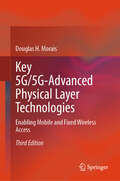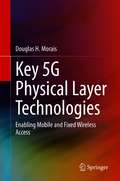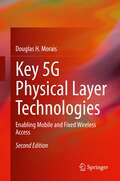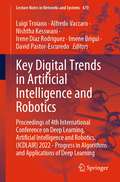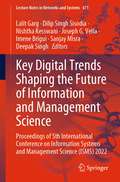- Table View
- List View
Kase on Technical Analysis Workbook: Trading and Forecasting (Bloomberg Financial)
by Cynthia A. KaseLearn all you need to know about trading and forecasting with technical analysis Kase on Technical Analysis is the ultimate guide to forecasting and trading technically, a comprehensive "all you need to know" review of the topics. Award-winning instructor, Cynthia A. Kase, CMT1, MFTA2, engineer, veteran energy trader, and one of the world's preeminent market technicians, captures her 30 plus years of experience in thirteen half-hour sessions, for more than six in-depth hours on technical analysis essentials. Viewers will develop a better understanding of charting and technical indicators, and get an inside look at cutting edge material based on Kase's own unique indicators and innovative approaches to trading and forecasting. The video describes key techniques for interpreting market behavior and developing a technical approach to trading. The workbook provides practice exercises that reinforce the concepts learned as Kase guides viewers through the various methodologies and their real-life applications to successful market interactions. Technical analysis is based on the premise that the behavior of a market reveals all that is known about it. Price action, volatility and rates of price changes may be harnessed by Kase's techniques to forecast future prices, identify low risk, high reward trading opportunities, and to cut losses while letting profits run. Kase on Technical Analysis shows how it's done, providing clear and wide-ranging instruction and expert insight that helps viewers to: Build a foundational understanding of charting and technical indicators, including an introduction to latest techniques Learn the most important technical methods for interpreting and analyzing market behavior Effectively apply technical analysis to trading strategy, risk management and market forecasting Formulate entry and exit strategies by using pattern recognition and properly applying technical indicators Technical analysis is a core discipline used by successful traders to assess market conditions and time trades. This package covers the aspects of technical analysis needed for intelligent interaction with the markets, from theory to practice, with concrete guidance toward real-world application. For traders wanting to "come up to speed" on technical analysis, for those wanting a refresher on the topic, as well as for seasoned traders looking for new ideas, Kase on Technical Analysis provides deep insight from a global authority. 1 Chartered Market Technician awarded by the Market Technicians Association 2 Master of Financial Technical Analysis awarded by the International Federation of Technical Analysts
Kawaii Engineering: Measurements, Evaluations, and Applications of Attractiveness (Springer Series on Cultural Computing)
by Michiko Ohkura“Kawaii” is a Japanese word that denotes “cute,” “lovable,” or “charming” although it does not have exactly the same meaning as those adjectives. This book proposes engineering methodologies for systematic measurement of the affective perception of kawaii, by using virtual reality and biological signals, and discusses the effectiveness of kawaii engineering for designing industrial products and services. Kawaii can draw sympathy from people and can embody a special kind of cute design, which reduces fear and makes dull information more acceptable and appealing. Following the introduction of the background of kawaii engineering in Chapter 1, Chapters 2 and 3 describe experiments on the systematic measurement and evaluation methods for kawaii products and affective evaluation experiments. Chapter 4 proposes a mathematical model to identify the physical attributes that determine kawaii in motion. Chapters 5 and 6 explain research that uses biological signals and eye-tracking. After a brief survey of psychological research on kawaii and cuteness in Chapter 7, Chapters 8 and 9 introduce the use of spoons designed to stimulate the appetite of the elderly and the practical implementation of an emotion-driven camera. Chapters 10–14 explain experimental research that examines kawaii perception of people from various cultural backgrounds. Kawaii Engineering will appeal to those who work on affective computing, product design, user experience design, virtual reality, and biological signals.
Keep Calm and Log On: Your Handbook for Surviving the Digital Revolution
by Gillian "Gus" AndrewsHow to survive the digital revolution without getting trampled: your guide to online mindfulness, digital self-empowerment, cybersecurity, creepy ads, trustworthy information, and more.Feeling overwhelmed by an avalanche of online content? Anxious about identity theft? Unsettled by the proliferation of fake news? Welcome to the digital revolution. Wait—wasn't the digital revolution supposed to make our lives better? It was going to be fun and put the world at our fingertips. What happened? Keep Calm and Log On is a survival handbook that will help you achieve online mindfulness and overcome online helplessness—the feeling that tech is out of your control—with tips for handling cybersecurity, creepy ads, untrustworthy information, and much more.Taking a cue from the famous World War II morale-boosting slogan (“Keep Calm and Carry On”), Gus Andrews shows us how to adapt the techniques our ancestors used to survive hard times, so we can live our best lives online. She explains why media and technology stress us out, and offers empowering tools for coping. Mindfulness practices can help us stay calm and conserve our attention purposefully. Andrews shares the secret of understanding our own opinions'' “family trees” in order to identify misleading “fake news.” She provides tools for unplugging occasionally, overcoming feelings that we are “bad at technology,” and taking charge of our security and privacy. Andrews explains how social media algorithms keep us from information we need and why “creepy ads” seem to follow us online. Most importantly, she urges us to work to rebuild the trust in our communities that the internet has broken.
Keeping the U.S. Computer and Communications Industry Competitive: Convergence of Computing, Communications, and Entertainment
by Steering Committee on Keeping the U.S. Computer Communications Industry Competitive: Convergence of Computing Communications EntertainmentInteractive multimedia and information infrastructure receive a lot of attention in the press, but what do they really mean for society? What are the most significant and enduring innovations? What does the convergence of digitally based technologies mean for U.S. businesses and consumers? This book presents an overview of the exciting but much-hyped phenomenon of digital convergence.
Keeping Your AI Under Control: A Pragmatic Guide to Identifying, Evaluating, and Quantifying Risks
by Anand TamboliMuch of our daily lives intertwine with artificial intelligence. From watching movies recommended by our entertainment streaming service, to interacting with customer service chatbots, to autotagging photos of friends in our social media apps, AI plays an invisible part in enriching our lives. While AI may be seen as a panacea for enterprise advancement and consumer convenience, it is still an emerging technology, and its explosive growth needs to be approached with proper care and preparation. How do we tackle the challenges it presents, and how do we make sure that it does precisely what it is supposed to do?In Keeping Your AI Under Control, author Anand Tamboli explores the inherent risk factors of the widespread implementation of artificial intelligence. The author delves into several real-life case studies of AI gone wrong, including Microsoft’s 2016 chatbot disaster, Uber’s autonomous vehicle fatally wounding a pedestrian, and an entire smart home in Germany dangerously malfunctioning because of one bad lightbulb. He expertly addresses the need to challenge our current assumptions about the infallibility of technology. The importance of data governance, rigorous testing before roll-out, a chain of human accountability, ethics, and much more are all detailed in Keeping Your AI Under Control. Artificial intelligence will not solve all of our problems for good, but it can (and will) present us with new solutions. These solutions can only be achieved with proper planning, continued maintenance, and above all, a foundation of attuned human supervision. What You Will LearnUnderstand various types of risks involved in developing and using AI solutionsIdentify, evaluate, and quantify risks pragmatically Utilize AI insurance to support residual risk managementWho This Book Is ForProgressive businesses that are on a journey to use AI (buyers/customers), technical and financial leaders in AI solution companies (solution vendors), AI system integrators (intermediaries), project and technology leads of AI deployment projects, technology purchase decision makers, CXOs and legal officers (solution users).
Kendo UI Cookbook
by Sagar GanatraThis book is an easy-to-follow guide full of hands-on examples that allows you to learn and build visually compelling web applications using the Kendo UI library. This book will do wonders for web developers having knowledge of HTML and Javascript and want to polish their skills in building applications using the Kendo UI library.
Kentico CMS 5 Website Development: Beginner's Guide
by Thom RobbinsThis book is written in a clear, easy-to-understand, and practical tutorial style taking the reader through relevant, real-world examples that can be put into practice immediately. Each topic is written in a practical way and is developed incrementally throughout the book. As the book progresses each chapter provides more detailed information to aid the reader in learning and understanding more about Kentico CMS and how to complete the tasks they need to build a dynamic, scalable, and responsive website. This book is designed for web developers, designers, webmasters, content editors, and marketing professionals who want to develop a fully featured web presence in a simple and straightforward process. No prior knowledge of Kentico CMS is expected. You do not require any detailed knowledge of programming or web development in order to follow this book. Any IT-confident individual will be able to use the book to produce an easy-to-navigate and usable website.
Keras 2.x Projects: 9 projects demonstrating faster experimentation of neural network and deep learning applications using Keras
by Giuseppe CiaburroDemonstrate fundamentals of Deep Learning and neural network methodologies using Keras 2.x Key Features Experimental projects showcasing the implementation of high-performance deep learning models with Keras. Use-cases across reinforcement learning, natural language processing, GANs and computer vision. Build strong fundamentals of Keras in the area of deep learning and artificial intelligence. Book Description Keras 2.x Projects explains how to leverage the power of Keras to build and train state-of-the-art deep learning models through a series of practical projects that look at a range of real-world application areas. To begin with, you will quickly set up a deep learning environment by installing the Keras library. Through each of the projects, you will explore and learn the advanced concepts of deep learning and will learn how to compute and run your deep learning models using the advanced offerings of Keras. You will train fully-connected multilayer networks, convolutional neural networks, recurrent neural networks, autoencoders and generative adversarial networks using real-world training datasets. The projects you will undertake are all based on real-world scenarios of all complexity levels, covering topics such as language recognition, stock volatility, energy consumption prediction, faster object classification for self-driving vehicles, and more. By the end of this book, you will be well versed with deep learning and its implementation with Keras. You will have all the knowledge you need to train your own deep learning models to solve different kinds of problems. What you will learn Apply regression methods to your data and understand how the regression algorithm works Understand the basic concepts of classification methods and how to implement them in the Keras environment Import and organize data for neural network classification analysis Learn about the role of rectified linear units in the Keras network architecture Implement a recurrent neural network to classify the sentiment of sentences from movie reviews Set the embedding layer and the tensor sizes of a network Who this book is for If you are a data scientist, machine learning engineer, deep learning practitioner or an AI engineer who wants to build speedy intelligent applications with minimal lines of codes, then this book is the best fit for you. Sound knowledge of machine learning and basic familiarity with Keras library would be useful.
Keras Deep Learning Cookbook: Over 30 recipes for implementing deep neural networks in Python
by Rajdeep Dua Manpreet Singh GhotraLeverage the power of deep learning and Keras to develop smarter and more efficient data modelsKey FeaturesUnderstand different neural networks and their implementation using KerasExplore recipes for training and fine-tuning your neural network modelsPut your deep learning knowledge to practice with real-world use-cases, tips, and tricksBook DescriptionKeras has quickly emerged as a popular deep learning library. Written in Python, it allows you to train convolutional as well as recurrent neural networks with speed and accuracy.The Keras Deep Learning Cookbook shows you how to tackle different problems encountered while training efficient deep learning models, with the help of the popular Keras library. Starting with installing and setting up Keras, the book demonstrates how you can perform deep learning with Keras in the TensorFlow. From loading data to fitting and evaluating your model for optimal performance, you will work through a step-by-step process to tackle every possible problem faced while training deep models. You will implement convolutional and recurrent neural networks, adversarial networks, and more with the help of this handy guide. In addition to this, you will learn how to train these models for real-world image and language processing tasks. By the end of this book, you will have a practical, hands-on understanding of how you can leverage the power of Python and Keras to perform effective deep learningWhat you will learnInstall and configure Keras in TensorFlowMaster neural network programming using the Keras library Understand the different Keras layers Use Keras to implement simple feed-forward neural networks, CNNs and RNNsWork with various datasets and models used for image and text classificationDevelop text summarization and reinforcement learning models using KerasWho this book is forKeras Deep Learning Cookbook is for you if you are a data scientist or machine learning expert who wants to find practical solutions to common problems encountered while training deep learning models. A basic understanding of Python and some experience in machine learning and neural networks is required for this book.
Keras Reinforcement Learning Projects: 9 projects exploring popular reinforcement learning techniques to build self-learning agents
by Giuseppe CiaburroA practical guide to mastering reinforcement learning algorithms using KerasKey FeaturesBuild projects across robotics, gaming, and finance fields, putting reinforcement learning (RL) into actionGet to grips with Keras and practice on real-world unstructured datasetsUncover advanced deep learning algorithms such as Monte Carlo, Markov Decision, and Q-learningBook DescriptionReinforcement learning has evolved a lot in the last couple of years and proven to be a successful technique in building smart and intelligent AI networks. Keras Reinforcement Learning Projects installs human-level performance into your applications using algorithms and techniques of reinforcement learning, coupled with Keras, a faster experimental library.The book begins with getting you up and running with the concepts of reinforcement learning using Keras. You’ll learn how to simulate a random walk using Markov chains and select the best portfolio using dynamic programming (DP) and Python. You’ll also explore projects such as forecasting stock prices using Monte Carlo methods, delivering vehicle routing application using Temporal Distance (TD) learning algorithms, and balancing a Rotating Mechanical System using Markov decision processes.Once you’ve understood the basics, you’ll move on to Modeling of a Segway, running a robot control system using deep reinforcement learning, and building a handwritten digit recognition model in Python using an image dataset. Finally, you’ll excel in playing the board game Go with the help of Q-Learning and reinforcement learning algorithms.By the end of this book, you’ll not only have developed hands-on training on concepts, algorithms, and techniques of reinforcement learning but also be all set to explore the world of AI.What you will learnPractice the Markov decision process in prediction and betting evaluationsImplement Monte Carlo methods to forecast environment behaviorsExplore TD learning algorithms to manage warehouse operationsConstruct a Deep Q-Network using Python and Keras to control robot movementsApply reinforcement concepts to build a handwritten digit recognition model using an image datasetAddress a game theory problem using Q-Learning and OpenAI GymWho this book is forKeras Reinforcement Learning Projects is for you if you are data scientist, machine learning developer, or AI engineer who wants to understand the fundamentals of reinforcement learning by developing practical projects. Sound knowledge of machine learning and basic familiarity with Keras is useful to get the most out of this book
Keras to Kubernetes: The Journey of a Machine Learning Model to Production
by Dattaraj RaoBuild a Keras model to scale and deploy on a Kubernetes cluster We have seen an exponential growth in the use of Artificial Intelligence (AI) over last few years. AI is becoming the new electricity and is touching every industry from retail to manufacturing to healthcare to entertainment. Within AI, we're seeing a particular growth in Machine Learning (ML) and Deep Learning (DL) applications. ML is all about learning relationships from labeled (Supervised) or unlabeled data (Unsupervised). DL has many layers of learning and can extract patterns from unstructured data like images, video, audio, etc. Keras to Kubernetes: The Journey of a Machine Learning Model to Production takes you through real-world examples of building DL models in Keras for recognizing product logos in images and extracting sentiment from text. You will then take that trained model and package it as a web application container before learning how to deploy this model at scale on a Kubernetes cluster. You will understand the different practical steps involved in real-world ML implementations which go beyond the algorithms. • Find hands-on learning examples • Learn to uses Keras and Kubernetes to deploy Machine Learning models • Discover new ways to collect and manage your image and text data with Machine Learning • Reuse examples as-is to deploy your models • Understand the ML model development lifecycle and deployment to production If you're ready to learn about one of the most popular DL frameworks and build production applications with it, you've come to the right place!
The Kerbal Player's Guide: The Easiest Way to Launch a Space Program
by Alasdair Allan Jon Manning Paris Buttfield-Addison Paul Fenwick Tim NugentKerbal Space Program (KSP) is a critically acclaimed, bestselling space flight simulator game. It’s making waves everywhere from mainstream media to the actual space flight industry, but it has a bit of a learning curve. In this book, five KSP nerds—including an astrophysicist—teach you everything you need to know to get a nation of tiny green people into space.KSP is incredibly realistic. When running your space program, you’ll have to consider delta-V budgets, orbital mechanics, Hohmann transfers, and more. This book is perfect for video game players, simulation game players, Minecrafters, and amateur astronomers.Design, launch, and fly interplanetary rocketsCapture an asteroid and fly it into a parking orbitTravel to distant planets and plant a flagBuild a moon rover, and jump off a crater ridgeRescue a crew-mate trapped in deep space
Kerberos: The Definitive Guide
by Jason GarmanKerberos, the single sign-on authentication system originally developed at MIT, deserves its name. It's a faithful watchdog that keeps intruders out of your networks. But it has been equally fierce to system administrators, for whom the complexity of Kerberos is legendary. Single sign-on is the holy grail of network administration, and Kerberos is the only game in town. Microsoft, by integrating Kerberos into Active Directory in Windows 2000 and 2003, has extended the reach of Kerberos to all networks large or small. Kerberos makes your network more secure and more convenient for users by providing a single authentication system that works across the entire network. One username; one password; one login is all you need. Fortunately, help for administrators is on the way. Kerberos: The Definitive Guide shows you how to implement Kerberos for secure authentication. In addition to covering the basic principles behind cryptographic authentication, it covers everything from basic installation to advanced topics like cross-realm authentication, defending against attacks on Kerberos, and troubleshooting. In addition to covering Microsoft's Active Directory implementation, Kerberos: The Definitive Guide covers both major implementations of Kerberos for Unix and Linux: MIT and Heimdal. It shows you how to set up Mac OS X as a Kerberos client. The book also covers both versions of the Kerberos protocol that are still in use: Kerberos 4 (now obsolete) and Kerberos 5, paying special attention to the integration between the different protocols, and between Unix and Windows implementations. If you've been avoiding Kerberos because it's confusing and poorly documented, it's time to get on board! This book shows you how to put Kerberos authentication to work on your Windows and Unix systems.
Kernel Learning Algorithms for Face Recognition
by Jeng-Shyang Pan Jun-Bao Li Shu-Chuan ChuKernel Learning Algorithms for Face Recognition covers the framework of kernel based face recognition. This book discusses the advanced kernel learning algorithms and its application on face recognition. This book also focuses on the theoretical deviation, the system framework and experiments involving kernel based face recognition. Included within are algorithms of kernel based face recognition, and also the feasibility of the kernel based face recognition method. This book provides researchers in pattern recognition and machine learning area with advanced face recognition methods and its newest applications.
Kernel Methods and Machine Learning
by S. Y. KungOffering a fundamental basis in kernel-based learning theory, this book covers both statistical and algebraic principles. It provides over 30 major theorems for kernel-based supervised and unsupervised learning models. The first of the theorems establishes a condition, arguably necessary and sufficient, for the kernelization of learning models. In addition, several other theorems are devoted to proving mathematical equivalence between seemingly unrelated models. With over 25 closed-form and iterative algorithms, the book provides a step-by-step guide to algorithmic procedures and analysing which factors to consider in tackling a given problem, enabling readers to improve specifically designed learning algorithms, build models for new applications and develop efficient techniques suitable for green machine learning technologies. Numerous real-world examples and over 200 problems, several of which are Matlab-based simulation exercises, make this an essential resource for graduate students and professionals in computer science, electrical and biomedical engineering. Solutions to problems are provided online for instructors.
Kernel Methods for Machine Learning with Math and Python: 100 Exercises for Building Logic
by Joe SuzukiThe most crucial ability for machine learning and data science is mathematical logic for grasping their essence rather than relying on knowledge or experience. This textbook addresses the fundamentals of kernel methods for machine learning by considering relevant math problems and building Python programs. The book’s main features are as follows:The content is written in an easy-to-follow and self-contained style.The book includes 100 exercises, which have been carefully selected and refined. As their solutions are provided in the main text, readers can solve all of the exercises by reading the book.The mathematical premises of kernels are proven and the correct conclusions are provided, helping readers to understand the nature of kernels.Source programs and running examples are presented to help readers acquire a deeper understanding of the mathematics used.Once readers have a basic understanding of the functional analysis topics covered in Chapter 2, the applications are discussed in the subsequent chapters. Here, no prior knowledge of mathematics is assumed.This book considers both the kernel for reproducing kernel Hilbert space (RKHS) and the kernel for the Gaussian process; a clear distinction is made between the two.
Kernel Methods for Machine Learning with Math and R: 100 Exercises for Building Logic
by Joe SuzukiThe most crucial ability for machine learning and data science is mathematical logic for grasping their essence rather than relying on knowledge or experience. This textbook addresses the fundamentals of kernel methods for machine learning by considering relevant math problems and building R programs. The book’s main features are as follows:The content is written in an easy-to-follow and self-contained style.The book includes 100 exercises, which have been carefully selected and refined. As their solutions are provided in the main text, readers can solve all of the exercises by reading the book.The mathematical premises of kernels are proven and the correct conclusions are provided, helping readers to understand the nature of kernels.Source programs and running examples are presented to help readers acquire a deeper understanding of the mathematics used.Once readers have a basic understanding of the functional analysis topics covered in Chapter 2, the applications are discussed in the subsequent chapters. Here, no prior knowledge of mathematics is assumed.This book considers both the kernel for reproducing kernel Hilbert space (RKHS) and the kernel for the Gaussian process; a clear distinction is made between the two.
Kernel Methods for Pattern Analysis
by John Shawe-Taylor Nello CristianiniKernel methods provide a powerful and unified framework for pattern discovery, motivating algorithms that can act on general types of data (e. g. strings, vectors or text) and look for general types of relations (e. g. rankings, classifications, regressions, clusters). The application areas range from neural networks and pattern recognition to machine learning and data mining. This book, developed from lectures and tutorials, fulfils two major roles: firstly it provides practitioners with a large toolkit of algorithms, kernels and solutions ready to use for standard pattern discovery problems in fields such as bioinformatics, text analysis, image analysis. Secondly it provides an easy introduction for students and researchers to the growing field of kernel-based pattern analysis, demonstrating with examples how to handcraft an algorithm or a kernel for a new specific application, and covering all the necessary conceptual and mathematical tools to do so.
Kernel Ridge Regression in Clinical Research
by Ton J. Cleophas Aeilko H. ZwindermanIBM (international business machines) has published in its SPSS statistical software 2022 update a very important novel regression method entitled Kernel Ridge Regression (KRR). It is an extension of the currently available regression methods, and is suitable for pattern recognition in high dimensional data, particularly, when alternative methods fail. Its theoretical advantages are plenty and include thekernel trick for reduced arithmetic complexity,estimation of uncertainty by Gaussians unlike histograms,corrected data-overfit by ridge regularization,availability of 8 alternative kernel density models for datafit.A very exciting and wide array of preliminary KRR research has already been published by major disciplines (like studies in quantum mechanics and nuclear physics, studies of molecular affinity / dynamics, atomisation energy studies, but also forecasting economics studies, IoT (internet of things) studies for e-networks, plant stress response studies, big data streaming studies, etc). In contrast, it is virtually unused in clinical research. This edition is the first textbook and tutorial of kernel ridge regressions for medical and healthcare students as well as recollection / update bench, and help desk for professionals. Each chapter can be studied as a standalone, and, using, real as well as hypothesized data, it tests the performance of the novel methodology against traditional regression analyses. Step by step analyses of over 20 data files stored at Supplementary Files at Springer Interlink are included for self-assessment. We should add that the authors are well qualified in their field. Professor Zwinderman is past-president of the International Society of Biostatistics (2012-2015) and Professor Cleophas is past-president of the American College of Angiology (2000-2002). From their expertise they should be able to make adequate selections of modern KRR methods for the benefit of physicians, students, and investigators. The authors have been working and publishing together for 24 years and their research can be characterized as a continued effort to demonstrate that clinical data analysis is not mathematics but rather a discipline at the interface of biology and mathematics.
Kernelization: Theory of Parameterized Preprocessing
by Fedor V. Fomin Daniel Lokshtanov Saket Saurabh Meirav ZehaviPreprocessing, or data reduction, is a standard technique for simplifying and speeding up computation. Written by a team of experts in the field, this book introduces a rapidly developing area of preprocessing analysis known as kernelization. The authors provide an overview of basic methods and important results, with accessible explanations of the most recent advances in the area, such as meta-kernelization, representative sets, polynomial lower bounds, and lossy kernelization. The text is divided into four parts, which cover the different theoretical aspects of the area: upper bounds, meta-theorems, lower bounds, and beyond kernelization. The methods are demonstrated through extensive examples using a single data set. Written to be self-contained, the book only requires a basic background in algorithmics and will be of use to professionals, researchers and graduate students in theoretical computer science, optimization, combinatorics, and related fields.
Key 5G/5G-Advanced Physical Layer Technologies: Enabling Mobile and Fixed Wireless Access
by Douglas H. MoraisThis third edition of this text covers the key technologies associated with the physical transmission of data on 5G mobile systems. Following an updated overview of these technologies, the author provides a high-level description of 3GPP’s mobile communications standard (5G/5G-Advanced) and shows how the key technologies presented earlier facilitate the transmission of very high-speed user data and control data and can provide very low latency for use cases where this is important. In the final chapter, an updated overview and the physical layer aspects of 5G NR enabled Fixed Wireless Access (FWA) networks is presented. Material in the second edition addressed mainly the key physical layer technologies and features associated with 3GPP Release 15, the first release to support 5G, and Release 16. This edition adds descriptions of some of the technological advancements supported in Releases 17 and 18, the latter being designated by 3GPP as 5G-Advanced. In addition to numerous enhancements of existing features, these releases include new features such as support for 1024-QAM in the downlink in the FR1 band, Reduced Capability (RedCAP) devices, Network Controlled repeaters, operation in the 6 GHz band and above 52.6 GHz, support for broadcast/multicast services, and Non-terrestrial Networks (NTNs). Additionally, a look ahead at some of the planned features and enhancements of Release 19 is provided. This textbook is intended for graduate and upper undergraduate engineering students and practicing engineers and technicians who have an interest in 3GPP’s 5G enabled mobile and or FWA networks and want to acquire, where missing, the necessary technology background in order to understand 3GPP’s physical layer specifications and operation. Provided are working problems and helpful examples throughout the text.
Key 5G Physical Layer Technologies: Enabling Mobile and Fixed Wireless Access
by Douglas H. MoraisThis book covers the key technologies associated with the physical transmission of data on fifth generation (5G) mobile systems. Following an overview of these technologies, a high-level description of 3GPP’s mobile communications standard (5G NR) is given and it is shown how the key technologies presented earlier facilitate the transmission of control data and very high-speed user data. In the final chapter, an overview and the physical layer aspects of 5G NR enabled Fixed Wireless Access (FWA) networks is presented. This book is intended for those practicing engineers and graduate and upper undergraduate engineering students who have an interest in 3GPP’s 5G enabled mobile and or FWA networks and want to acquire, where missing, the necessary technology background in order to understand 3GPP’s physical layer specifications and operation.Provides a comprehensive covering of key 3GPP 5G NR physical layer technologies, presented in a clear, tractable fashion, with sufficient mathematics to make it technically coherent;Addresses all key 5G NR technologies, including digital modulation, LDPC and Polar coding, multicarrier based multiple access techniques, and multiple antenna techniques including MIMO and beamforming;Presents an overview of 5G NR Radio Access Network (RAN) architecture and a detailed understanding of how user and control data is transported in the physical layer by the application of the technologies presented;Provides an overview and addresses physical layer aspects of 5G NR enabled Fixed Wireless Access networks.
Key 5G Physical Layer Technologies: Enabling Mobile and Fixed Wireless Access
by Douglas H. Morais This updated book, reconfigured as a textbook, covers the key technologies associated with the physical transmission of data on 5G mobile systems. Following an updated overview of these technologies, the author provides a high-level description of 3GPP’s mobile communications standard (5G NR) and shows how the key technologies presented earlier facilitate the transmission of very high-speed user data and control data and can provide very low latency for use cases where this is important. In the final chapter, an overview and the physical layer aspects of 5G NR enabled Fixed Wireless Access (FWA) networks is presented. Material in the first edition addressed mainly the key physical layer technologies and features associated with 3GPP release 15, the first release to support 5G. This edition adds descriptions of some of the technological advancements supported in release 16, including integrated access and backhaul (IAB), sidelink communication, NR positioning, operation in unlicensed bands, and multiple transmission points transmission. This textbook is intended for graduate and upper undergraduate engineering students and practicing engineers who have an interest in 3GPP’s 5G enabled mobile and or FWA networks and want to acquire, where missing, the necessary technology background in order to understand 3GPP’s physical layer specifications and operation. The author provides working problems and helpful examples throughout the text.
Key Digital Trends in Artificial Intelligence and Robotics: Proceedings of 4th International Conference on Deep Learning, Artificial Intelligence and Robotics, (ICDLAIR) 2022 - Progress in Algorithms and Applications of Deep Learning (Lecture Notes in Networks and Systems #670)
by Luigi Troiano Alfredo Vaccaro Nishtha Kesswani Irene Díaz Rodriguez Imene Brigui David Pastor-EscuredoThe book (proceedings of the 4th International Conference on Deep Learning, Artificial Intelligence and Robotics (ICDLAIR) 2022) introduces key topics from artificial intelligence algorithms and programming organisations and explains how they contribute to health care, manufacturing, law, finance, retail, real estate, accountancy, digital marketing, and various other fields. Although artificial intelligence (AI) has generated a lot of hype over the past ten years, these consequences on how we live, work, and play are still in their infancy and will likely have a significant impact in the future. The supremacy of AI in areas like speech and picture recognition, navigational apps, personal assistants for smartphones, ride-sharing apps, and many other areas is already well established. The book is primarily meant for academics, researchers, and engineers who want to employ AI applications to address real-world issues. The authors hope that businesses and technology creators will also find it appealing to utilise in industry.
Key Digital Trends Shaping the Future of Information and Management Science: Proceedings of 5th International Conference on Information Systems and Management Science (ISMS) 2022 (Lecture Notes in Networks and Systems #671)
by Lalit Garg Dilip Singh Sisodia Nishtha Kesswani Joseph G. Vella Imene Brigui Sanjay Misra Deepak SinghThis book (proceedings of ISMS 2022) is intended to be used as a reference by students and researchers who collect scientific and technical contributions with respect to models, tools, technologies and applications in the field of information systems and management science. This textbook shows how to exploit information systems in a technology-rich management field. The book introduces concepts, principles, methods, and procedures that will be valuable to students and scholars in thinking about existing organization systems, proposing new systems, and working with management professionals in implementing new information systems.
